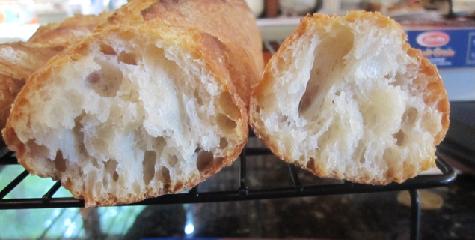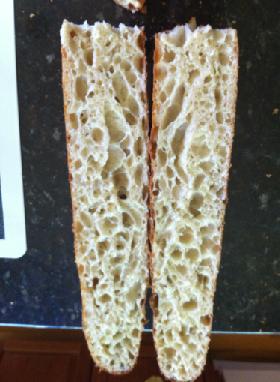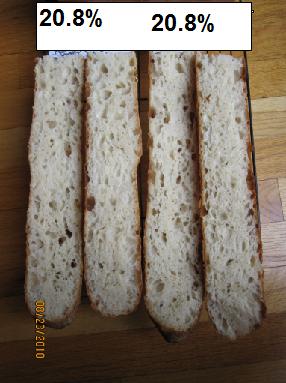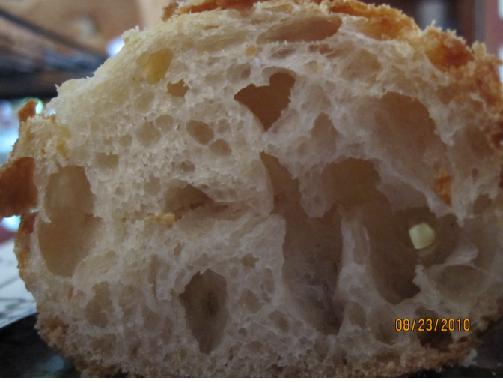
Heavy baguettes are good too?
I have a question.
When I tried to make a Gosselin or Mr Nippon's looking baguette, They turned out both of them were heavy baguettes. They are looking good indeed. My question is that is right? they are supposed to be heavy? I never had real one so that I can't figure it out. I hope that somebody tell me the fact.


Have you ever heard that a ratio of how much water the baguette lost ?
Here is the one that I heard of in Japan.
A ( The baguette's weight before baking ) - B( The baguette's weight after baking) ÷ A x100 = Ratio of how much water the baguette lost.
The baguette's ratio is supposed to be around 20%-23% by Japanese bakery books. You can judge between good one and bad one depend on this. The pictures above are around 17%
There are two of baguettes that I made today are light. see picture below:


All of them are 80% hydration. I like light baguettes.
Best wishes,
Akiko


Comments
Akiko,
The water loss depends on multiple variables, such as humidity (amount of steam) in the oven, baking time, baking temperature, and salt to flour ratio. How are baguettes baked in Nihon? Maybe a technique difference would account for the variability.
The baguettes in the pictures look good, both yours and the examples. You seem to have a tighter crumb than those in the pictures above.
I am intrigued by your information; however, and now I will see what ratio of water loss mine yield when I bake more this weekend.
-Matt
Matt,
Thank you for your help. I really apperciate it. In Japan , there are many variation methods like here. but most of Japanese bakers use cold-fermentation and cold water. My recipe is here: click on this
http://www.thefreshloaf.com/node/19118/how-i-finally-have-open-crumb-and-ear-without-pouring-water-or-using-high-heat-500f
This is a way to have a heavy baguette: When I use ice cold water for poolish and final day, I let it rise at 70F for 3 hours as usual ( the dough was small and tough) It was still small and looks like a softer play dough before the second proof) After the second proof at 74 F for 35 minutes, the dough was little flattern. When I was watching them while baking, the dough rose well. Taking out the baguette of the oven, it was a heavy baguette although it has a lot of holes and shiny crumb. Note: I decreased amount of yeast down to 0.4% that is a key to have lots of holes and shiny crumb in my opinion. also less knead. In my recipe, The yeast is 0.8%
I know many folks here use less yeast than Japanese home bakers. because we like softer crust to bite easily in my opinion, but we usually have tight crumb.
This is another heavy baguette ( it was 15%) I baked last week. I have baked 2 different kind of baguettes everyday to compare. I am looking forward to hearing your result! :)
Best wishes,
Akiko
I say bake them however you like! If you like a heftier baguette, theres no reason to do otherwise.
In my own humble opinion, especially baguettes, like many other bakery products should be large and light. Lots of volume, but not very dense. They should please the eye, and look substantial, but not make you feel heavy after you have eaten it.
Ultimately, I don't think the percentage of water lost from mixing to cooling should hold priority in your plans; little details like that can really throw us off from what makes our bread really gratifying and satisfying to us.
--Chausiubao
Chausiubao,
I am glad to hear your opinion that is reasonable. I was wondering when I see a couple of Gosselin baguette pictures on Google search, They are very watery, but is it light too? It looks like light. That is my question.
When I think of Bagels, When you check your bagels are ready or not, you put the bagel in a cold water and it is ready to boil if the bagel float up immediately that is I got this information by BBA. It happens to the same thing to baguettes, I wonder. My dense baguettes look heavy before baking too. But as I see the result, I can have a nice looking baguettes, watery, shiny, and big holes in it.
After all, It doesn't matter if my baguettes are heavy or not... I want to think about the way.. but I can't ... Whenever I bake baguettes, I have a lot of things I don't understand and I want to know like my daughter 4 years old. "WHY?" "WHY?".... :)
Sincerely,
Akiko
Akiko,
I hadn't measured the 'after weight' of my baguettes until I saw your post, but I'd noticed that the lighter ones have a crispier crust and of course more open crumb.
The ones I just pulled out of the oven went in at 470g and came out at 360g, so they would be at 23.4%.
-Mark
http://TheBackHomeBakery.com
Mark,
Thank you for your responce. That is very helpful, and I checked your website that is very impressive! As if I can smell your professional breads and atomosphere too.
Your baguettes are very light as I see the percentage. And, Your baguette on the website is wonderful!! That is very nice crumb what I was exactly looking for. I truely admire your breads.
Many thanks to you,
Akiko
I think that I might figure it out why I had such a heavy baguettes. Because I didn't let the dough rise at the right tempareture and humidity for the cold baguette that has a little of bit of yeast.
Here is 2 baguettes that I baked today. One is my recipe, and the other one is that I decreased yeast down to 0.4% in total. I will continue to bake 2 baguettes that the yeast are 0.4% each tomorrow.
↑Yeast 0.8%
↑Yeast 0.4%
Two of them are 22.4%. They were light enough to make me happy.
I really appreciate for all of you who helped me. Thank you!!!
----- ------ ----
My husband prefers 0.8% yeast's baguette to the 0.4%'s. My son likes the 0.4%'s more than the 0.8%'s. I think I like the 0.8%'s because is better for sandwiches. It is easy to bite off. Taste is more important than looking, I think....
Baking is fun!
Akiko